Coprolite
A coprolite (also known as a crapstone) is fossilized feces. Coprolites are classified as trace fossils as opposed to body fossils, as they give evidence for the animal's behaviour (in this case, diet) rather than morphology. The name is derived from the Greek words κόπρος (kopros, meaning "dung") and λίθος (lithos, meaning "stone"). They were first described by William Buckland in 1829. Prior to this they were known as "fossil fir cones" and "bezoar stones". They serve a valuable purpose in paleontology because they provide direct evidence of the predation and diet of extinct organisms.[1] Coprolites may range in size from a few millimetres to over 60 centimetres.
| Part of a series on |
| Paleontology |
|---|
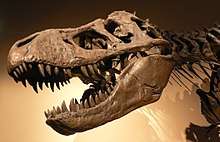 |
|
Fossils
|
|
Natural history |
|
Organs and processes
|
|
Evolution
|
|
History of paleontology |
|
Branches of paleontology |
|
Paleontology Portal Category |
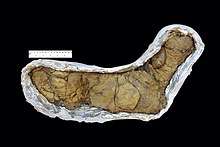
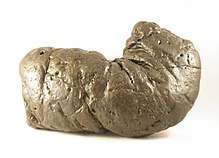
_from_South_Carolina%2C_USA..jpg)
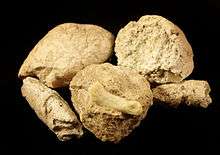
Coprolites, distinct from paleofaeces, are fossilized animal dung. Like other fossils, coprolites have had much of their original composition replaced by mineral deposits such as silicates and calcium carbonates. Paleofaeces, on the other hand, retain much of their original organic composition and can be reconstituted to determine their original chemical properties, though in practice the term coprolite is also used for ancient human faecal material in archaeological contexts.[2][3][4]
Initial discovery
The fossil hunter Mary Anning noticed as early as 1824 that "bezoar stones" were often found in the abdominal region of ichthyosaur skeletons found in the Lias formation at Lyme Regis.[5] She also noted that if such stones were broken open they often contained fossilized fish bones and scales as well as sometimes bones from smaller ichthyosaurs. It was these observations by Anning that led the geologist William Buckland to propose in 1829 that the stones were fossilized feces and name them coprolites. Buckland also suspected that the spiral markings on the fossils indicated that ichthyosaurs had spiral ridges in their intestines similar to those of modern sharks, and that some of these coprolites were black with ink from swallowed belemnites.[6]
Research value
By examining coprolites, paleontologists are able to find information about the diet of the animal (if bones or other food remains are present), such as whether it was a herbivorous or carnivorous, and the taphonomy of the coprolites, although the producer is rarely identified unambiguously, especially with more ancient examples.[7] In some instances, knowledge about the anatomy of animal digestive tracts can be helpful in assigning a coprolite to the animal that produced it, one example being the finding that the Triassic dinosauriform Silesaurus may have been an insectivore, a suggestion which was based on the beak-like jaws of the animal and the high density of beetle remains found in associated coprolites.[8] Further, coprolites can be analyzed for certain minerals that are known to exist in trace amounts in certain species of plant that can still be detected millions of years later.[9]
Recognizing coprolites
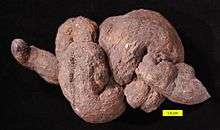
The recognition of coprolites is aided by their structural patterns, such as spiral or annular markings, by their content, such as undigested food fragments, and by associated fossil remains. The smallest coprolites are often difficult to distinguish from inorganic pellets or from eggs. Most coprolites are composed chiefly of calcium phosphate, along with minor quantities of organic matter. By analyzing coprolites, it is possible to infer the diet of the animal which produced them.
Coprolites have been recorded in deposits ranging in age from the Cambrian period [10] to recent times and are found worldwide. Some of them are useful as index fossils, such as Favreina from the Jurassic period of Haute-Savoie in France.
Some marine deposits contain a high proportion of fecal remains. However, animal excrement is easily fragmented and destroyed, so usually has little chance of becoming fossilized.
Coprolite mining
In 1842 the Rev John Stevens Henslow, a professor of Botany at St John's College, Cambridge, discovered coprolites just outside Felixstowe in Suffolk in the villages of Trimley St Martin,[11] Falkenham and Kirton[12] and investigated their composition. Realising their potential as a source of available phosphate once they had been treated with sulphuric acid, he patented an extraction process and set about finding new sources.[13] Very soon, coprolites were being mined on an industrial scale for use as fertiliser due to their high phosphate content. The major area of extraction occurred over the east of England, centred on Cambridgeshire and the Isle of Ely[14][15] with its refining being carried out in Ipswich by the Fison Company.[15] There is a Coprolite Street near Ipswich docks where the Fisons works once stood.[16] The industry declined in the 1880s[15][11] but was revived briefly during the First World War to provide phosphates for munitions.[14] A renewed interest in coprolite mining in the First World War extended the area of interest into parts of Buckinghamshire as far west as Woburn Sands.[13]
See also
| Look up coprolite in Wiktionary, the free dictionary. |
- Bromalite
- Fecalith
- Fossil
- Fossils and the geological timescale
- Gastrolith
- Guano
- Lloyds Bank coprolite
- Regurgitalith
- The World of Poo
- Petrifaction
- Petrified wood
Notes
- "coprolite". Dictionary.com.
- Gilbert MT, Jenkins DL, Götherstrom A, Naveran N, Sanchez JJ, Hofreiter M, Thomsen PF, Binladen J, Higham TF, Yohe RM, Parr R, Cummings LS, Willerslev E (May 2008). "DNA from pre-Clovis human coprolites in Oregon, North America". Science. 320 (5877): 786–9. Bibcode:2008Sci...320..786G. doi:10.1126/science.1154116. PMID 18388261.
- Poinar H, Fiedel S, King CE, Devault AM, Bos K, Kuch M, Debruyne R (July 2009). "Comment on "DNA from pre-Clovis human coprolites in Oregon, North America"". Science. 325 (5937): 148, author reply 148. Bibcode:2009Sci...325..148P. doi:10.1126/science.1168182. PMID 19589985.
- Goldberg P, Berna F, Macphail RI (July 2009). "Comment on "DNA from pre-Clovis human coprolites in Oregon, North America"". Science. 325 (5937): 148, author reply 148. Bibcode:2009Sci...325R.148G. doi:10.1126/science.1167531. PMID 19589984.
- Torrens, H. "Mary Anning (1799–1847) of Lyme;'the greatest fossilist the world ever knew'". British Journal for the History of Science. 28 (3): 257–284. doi:10.1017/S0007087400033161.
- Rudwick, Martin Worlds Before Adam: The Reconstruction of Geohistory in the Age of Reform pp. 154-155.
- Abhi (18 November 2005). "The Wonders of Dinosaur Dung". Sepia Mutiny.
- Martin Qvarnström; Joel Vikberg Wernström; Rafał Piechowski; Mateusz Tałanda; Per E. Ahlberg; Grzegorz Niedźwiedzki (2019). "Beetle-bearing coprolites possibly reveal the diet of a Late Triassic dinosauriform". Royal Society Open Science. 6 (3): Article ID 181042. Bibcode:2019RSOS....681042Q. doi:10.1098/rsos.181042. PMC 6458417. PMID 31031991.
- Bakalar N (18 November 2005). "Dung Fossils Suggest Dinosaurs Ate Grass". National Geographic News.
- Julien Kimmig & Luke C. Strotz (2017). "Coprolites in mid-Cambrian (Series 2-3) Burgess Shale-type deposits of Nevada and Utah and their ecological implications" (PDF). Bulletin of Geosciences. 92 (3): 297–309. doi:10.3140/bull.geosci.1667. Archived from the original (PDF) on 2017-08-09. Retrieved 2017-08-08.
- Berridge Eve (2004). "Trimley St Martin and the Coprolite Mining Rush" (PDF). Archived from the original (PDF) on 2007-10-08.
- Bernard O'Connor (2009). "(Corpolites in) Kirton, Suffolk". Retrieved 2017-02-02.
- O'Connor B, Ford TD (2001). "The Origins and Development of the British Coprolite Industry" (PDF). Mining History: The Bulletin of the Peak District Mines Historical Society. 14 (5). Archived from the original (PDF) on 2017-02-02. Retrieved 2017-02-02.
- Grove R (1976). "Coprolite Mining in Cambridgeshire" (PDF). Agricultural History Review. 24 (1). Archived from the original (PDF) on 2006-03-09.
- "Cambridgeshire - The Coprolite Mining Industry". EnglandGenWeb. 13 January 2000.
- "Industrial Revolution". BBC Suffolk. Archived from the original on 2006-02-20.
References
- Spencer, P. K. (1993). "The "coprolites" that aren't: the straight poop on specimens from the Miocene of southwestern Washington State". Ichnos. 2 (3): 1–6. doi:10.1080/10420949309380097.
